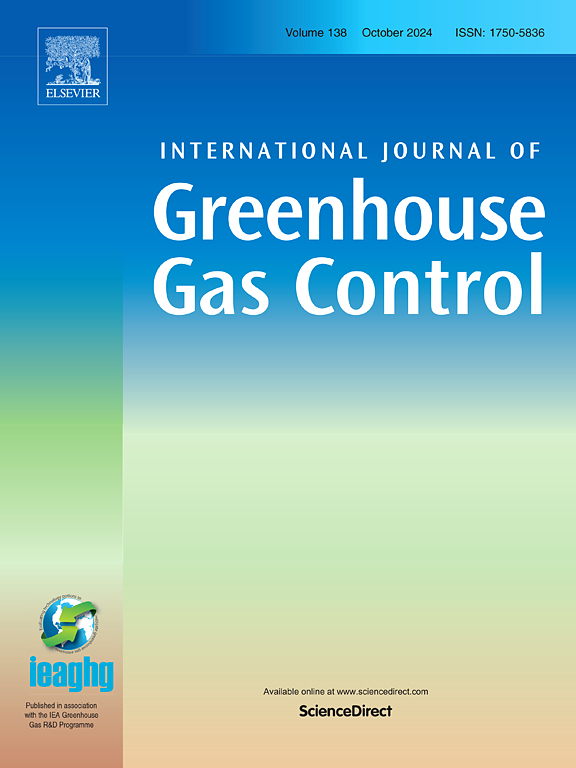Evaluation of data-driven models for post-combustion CO2 capture: A comparative analysis of accuracy, robustness and feasibility
IF 5.2
3区 工程技术
Q2 ENERGY & FUELS
International Journal of Greenhouse Gas Control
Pub Date : 2025-08-21
DOI:10.1016/j.ijggc.2025.104450
引用次数: 0
Abstract
This study examines the predictive performance, preprocessing impact, computational feasibility, and robustness of data-driven models in simulating absorber behaviour in carbon capture systems under real-world conditions. Five algorithms — Dynamic Mode Decomposition (simplified and full), Autoregressive Integrated Moving Average, Random Forest, Support Vector Regression, and Long Short-Term Memory networks — were evaluated across three preprocessing scenarios: Robust Principal Component Analysis with and without interpolation, and unprocessed data. Results show that preprocessing generally improves accuracy, with RPCA-based approaches outperforming untreated datasets across most horizons, although its impact on robustness under noise remains limited. Robustness analysis was conducted on the three best-performing models — DMD, ARIMA, and LSTM — revealing distinct behaviours. Dynamic Mode Decomposition was the most computationally efficient, providing near-instantaneous training and prediction, and maintained acceptable performance under noise. ARIMA exhibited strong robustness and predictive capacity, with minimal performance degradation across noise levels. In contrast, Long Short-Term Memory networks, while effective for long-term forecasting, displayed high computational costs and significant sensitivity to stochastic training effects. These limitations resulted in inconsistent performance across noise levels, even under low perturbations. The study highlights trade-offs between accuracy, feasibility, and robustness, stressing the importance of aligning model choice with deployment constraints. While black-box methods offer strong predictions, their sensitivity to randomness and computational demands hinder practical use. Robust and reproducible approaches like DMD balance efficiency and reliability, making them well-suited for industrial carbon capture applications.
燃烧后二氧化碳捕获数据驱动模型的评估:准确性、稳健性和可行性的比较分析
本研究考察了数据驱动模型在模拟现实世界条件下碳捕获系统吸收体行为时的预测性能、预处理影响、计算可行性和鲁棒性。五种算法——动态模式分解(简化和完整)、自回归综合移动平均、随机森林、支持向量回归和长短期记忆网络——在三种预处理方案中进行了评估:有和没有插值的鲁棒主成分分析,以及未处理的数据。结果表明,预处理通常可以提高精度,基于rpca的方法在大多数层面上都优于未经处理的数据集,尽管其对噪声下鲁棒性的影响仍然有限。对三个表现最好的模型- DMD, ARIMA和LSTM -进行鲁棒性分析,揭示了不同的行为。动态模态分解是计算效率最高的,提供近瞬时的训练和预测,并在噪声下保持可接受的性能。ARIMA表现出强大的鲁棒性和预测能力,在噪声水平上的性能下降最小。相比之下,长短期记忆网络虽然对长期预测有效,但计算成本高,对随机训练效果敏感。这些限制导致不一致的性能跨越噪声水平,即使在低扰动。该研究强调了准确性、可行性和健壮性之间的权衡,强调了将模型选择与部署约束保持一致的重要性。虽然黑盒方法提供了强有力的预测,但它们对随机性和计算需求的敏感性阻碍了实际应用。像DMD这样稳健且可重复的方法平衡了效率和可靠性,使其非常适合工业碳捕获应用。
本文章由计算机程序翻译,如有差异,请以英文原文为准。
求助全文
约1分钟内获得全文
求助全文
来源期刊
CiteScore
9.20
自引率
10.30%
发文量
199
审稿时长
4.8 months
期刊介绍:
The International Journal of Greenhouse Gas Control is a peer reviewed journal focusing on scientific and engineering developments in greenhouse gas control through capture and storage at large stationary emitters in the power sector and in other major resource, manufacturing and production industries. The Journal covers all greenhouse gas emissions within the power and industrial sectors, and comprises both technical and non-technical related literature in one volume. Original research, review and comments papers are included.

 求助内容:
求助内容: 应助结果提醒方式:
应助结果提醒方式:


